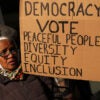Last week, the Obama Administration issued new regulations broadening Title IX of the Higher Education Act—the part of law barring sex-based discrimination in education programs typically associated with high school and college sports—to explicitly include science, technology, engineering, and mathematics (STEM) education.
As many commentators have noted, this new policy could effectively create science quotas and once again shows that the Administration is focused on equality of outcomes, not equality of opportunity. As Charlotte Allen notes over at Minding the Campus:
When college women study science, they tend to gravitate toward biology—about 58 percent of all bachelor’s, master’s, and doctoral degrees in biology go to women. In contrast, women earn some 17 percent of bachelor’s degrees in engineering and computer science and just over 40 percent of bachelor’s degrees in physical sciences and mathematics. The likely reason for this, found in the study “The Mathematics of Sex” (2009) by Cornell psychologists Stephen J. Ceci and Wendy M. Williams, is that women tend to be drawn to “organic” fields involving people and living things, whereas men are more interested in the objects and abstractions that are the focus of STEM majors.
Yet the Obama administration sticks closely to the hard-line feminist argument that the problem is bias: women are somehow being denied access to STEM courses.
As Hans Bader of the Competitive Enterprise Institute notes, existing Title IX regulations have restricted the number of men participating in sports to the overall percentage of men that make up the student body, which has limited sports options for men at universities. Carrie Lukas of the Independent Women’s Forum (IWF) echoes that analysis:
As a result, while Title IX succeeded in creating opportunities for women, it has also robbed men of similar opportunities.…
Title IX has contributed to the elimination of scores of men’s athletic teams (commonly baseball, wrestling, gymnastics, track and field, swimming, and crew) and the near extinction of some sports (like gymnastics) for men at the college level.
While women are underrepresented in some academic areas, they are also overrepresented in others. And if the Administration’s new Title IX guidance were applied evenly, opportunities for women in other fields would be limited. But as education researcher Joanne Jacobs notes, “don’t hold your breath waiting for Title IX enforcers to crack down on college English departments.”
Could there be any worse way to ensure access to science education? Pulling down men to alleviate a nonexistent problem plaguing women is surely no way to improve academic opportunity for everyone.
As Allen concludes: “The use of Title IX to force universities to restructure their curricula and alter the composition of their hard-science and engineering departments in order to achieve a supposed gender equity that matches neither the aptitudes nor the interests of many women isn’t just heavy-handed and totalitarian. As study after study indicates, it’s bad science as well.” And as IWF’s Sabrina Schaeffer writes:
Before we look to broaden the parameters of Title IX, we ought to give serious thought to the question: Is gender parity in the sciences really necessary in order to have gender equality? Can we accept that men and women see the world differently and choose to engage in different disciplines? Perhaps then we can finally value the differences men and women each bring to the table.
Fifty-seven percent of students enrolling in college in 2010 were women, the same year that women surpassed men for the first time in doctoral degrees earned. Moreover, the coming higher education revolution, which is harnessing the power of online options to bring down costs and improve access, will have a far greater impact on ensuring that everyone has access to educational opportunity than the Administration’s top-down regulations ever will.





























12 Replies to “Obama Administration Broadens Gender Quotas in Higher Ed”